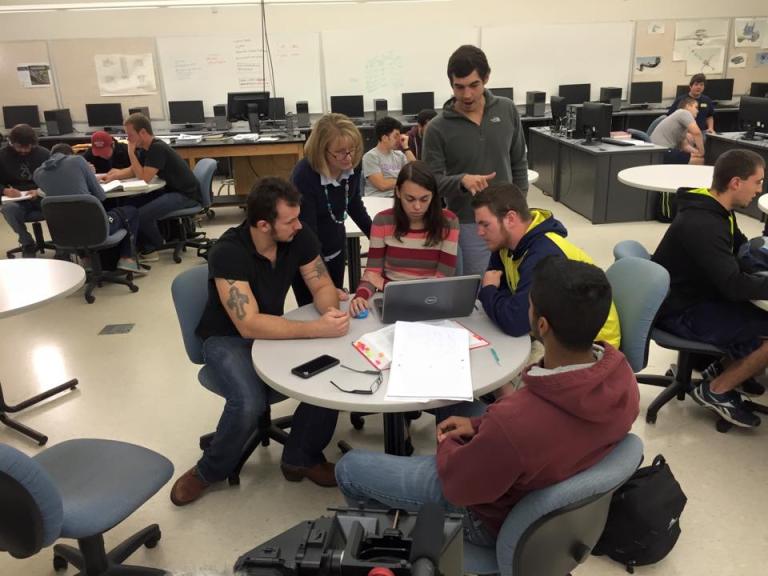
“If I can make the smallest difference and improve quality of life for someone, it’s good.”
Dr. Theresa Atkinson, Kettering University Mechanical Engineering faculty member, has recently partnered with McLaren Flint orthopaedic surgery residents to research ankle fractures at Flint hospitals and their work led to recommendations on how to better respond to them from a medical and automotive safety perspectives.
Atkinson spent two years, thanks to a McLaren Foundation grant, gathering data on ankle fractures occurring in the Flint area. The research group also looked at injuries in a national crash injury database. Of the fractures reported to the National Trauma Data Bank, ankle fractures are the most common fracture doctors see in the emergency department.
They’re also some of the most common injuries in adults who are treated by orthopedic surgeons. But it’s not something that’s often studied, Atkinson said.
Questions the researches examined included factors that cause the injuries and what makes people higher risk for the injuries. The research might have also brought to light some new information about what causes weak and fragile bones.
“Our work appears to be the first to identify a potential link between smoking and ankle fracture risk,” Atkinson said. “I find researching medical studies and structures going inside people to be very satisfying. If I can make the smallest difference and improve quality of life for someone, it’s good. Cars are fun but people are much more complicated in many ways.”
With a team of orthopedic residents, Atkinson set out to see what could be learned from researching the ankle fractures and what caused them.
There were 127 ankle fractures in 121 patients during the collection period. In terms of mechanism, motor vehicle accidents were the most common cause of ankle fractures, accounting for over 23 percent of the cases.
With the research, Atkinson and her team found that the more severe, more frequent fractures were in the winter months. But they also found that many of the ankle fractures happened on the evenings and weekends when senior surgeons are typically not at the hospital.
The research will help hospitals identify busy emergency department times so they can develop better training and staffing plans.
“We can make sure the right people are in the right places to administer the best care, the best medical coverage,” Atkinson said.
Aside from paying attention to nights and weekends for medical staff, they also found lifestyle results. They found correlation between diabetes and smoking and ankle fractures. The smoking correlation was a relatively new concept, Atkinson said.
“When you’re diabetic, your bone doesn’t get as much nutrition,” she said. “The one that was a surprise was smoking. We’re the first group to show that this traumatic fracture could be attributed to smoking.
“People thought it could affect your healing, but we had a significantly higher number of smokers in our fracture set than the county health association said we should have. We will go back to do more work to understand it and give family physicians information for families to encourage them not to smoke because it makes bones weaker.”
Next the team looked at the crash safety side of their research. They found heavier body mass index puts people at a higher risk of ankle injury in motor vehicle crashes. If it’s a frontal crash or a more head-on crash there’s a higher risk of an ankle fracture and the person at greatest risk is the driver. More than likely it will be the right foot that’s fractured unless it’s a really bad crash, then it’s the left ankle and the fractures tend to be more serious. Atkinson hopes this information will help spur more studies in crash safety labs, looking at how vehicles can be built to protect occupants from ankle fractures.
This is crucial to look at because an ankle fracture can lead to someone being off their feet for six months, Atkinson said. That, in turn can lead to job loss. Ankle fractures can lead to lifelong disability, she said.
The research Atkinson and her team were doing in part feeds into a new test the Insurance Institute of Highway Safety (IIHA) developed. The IIHS test simulates a frontal crash where most of the vehicle contact is on the driver’s side.
It simulates a “real life” serious crash that results in crushing forces around the driver and a high risk of serious injury.
Currently crash test dummies aren’t required to measure anything past the knee, Atkinson said, and this research, along with others, could show the need for that.
“This work and the IIHS test may change how auto companies design the car,” Atkinson said. “It’s starting to get more attention.”
In the end, the study helped medical residents, hospital staff and researchers understand more about how and why ankle fractures occur, in hopes of preventing them or treating them better in the future. Science and engineering joined forces with medical research to make a difference.
“I apply physics to help people not get hurt. If they do get hurt, I hope my work helps show them what they can do better next time,” Atkinson said. “It’s very stimulating because I have the opportunity to look at an X-ray and use physics to understand what happened, but I don’t have the ability to look at it to see what the person’s quality of life will be down the road. The medical residents and surgeons bring that deeper context with them.”